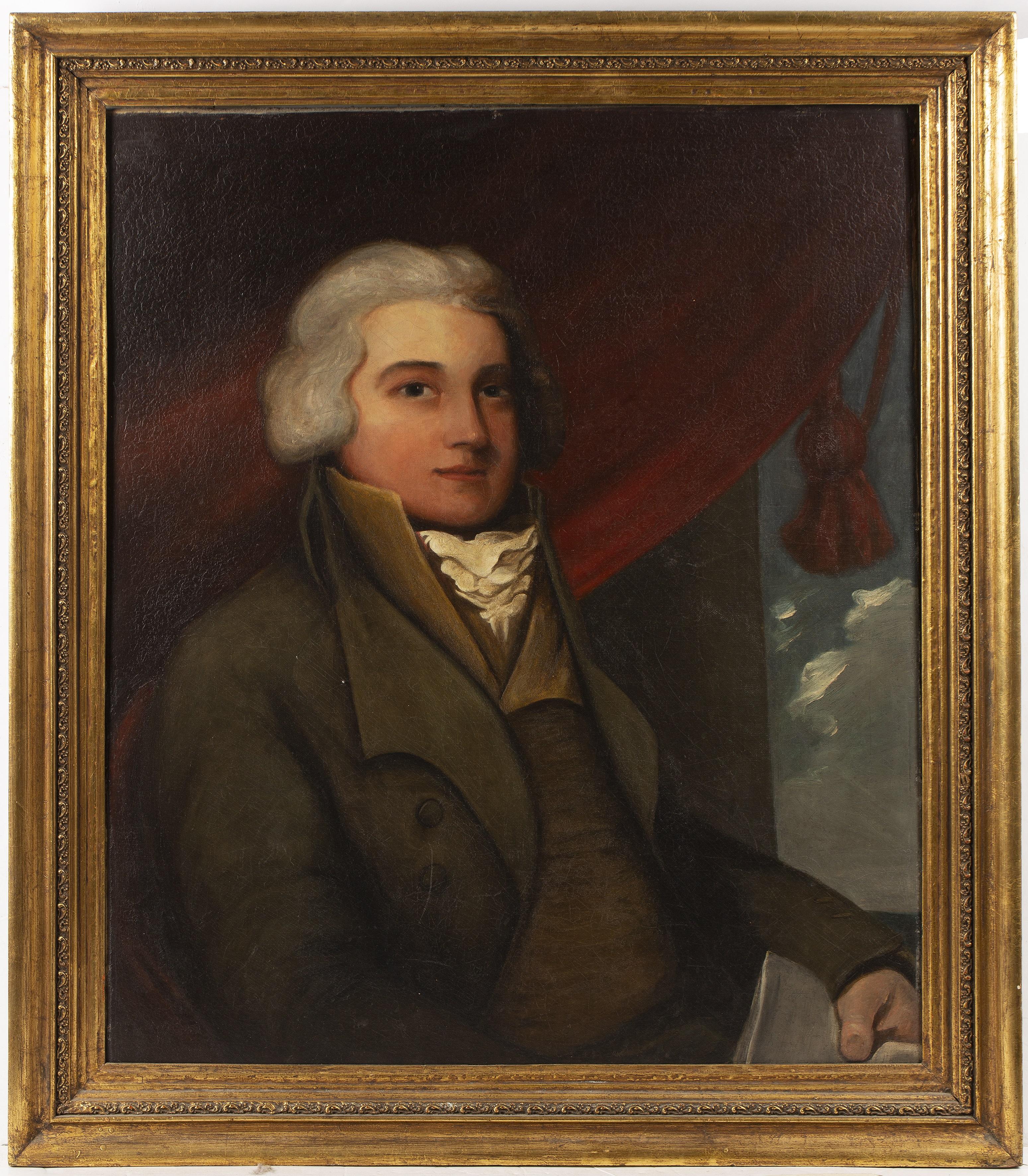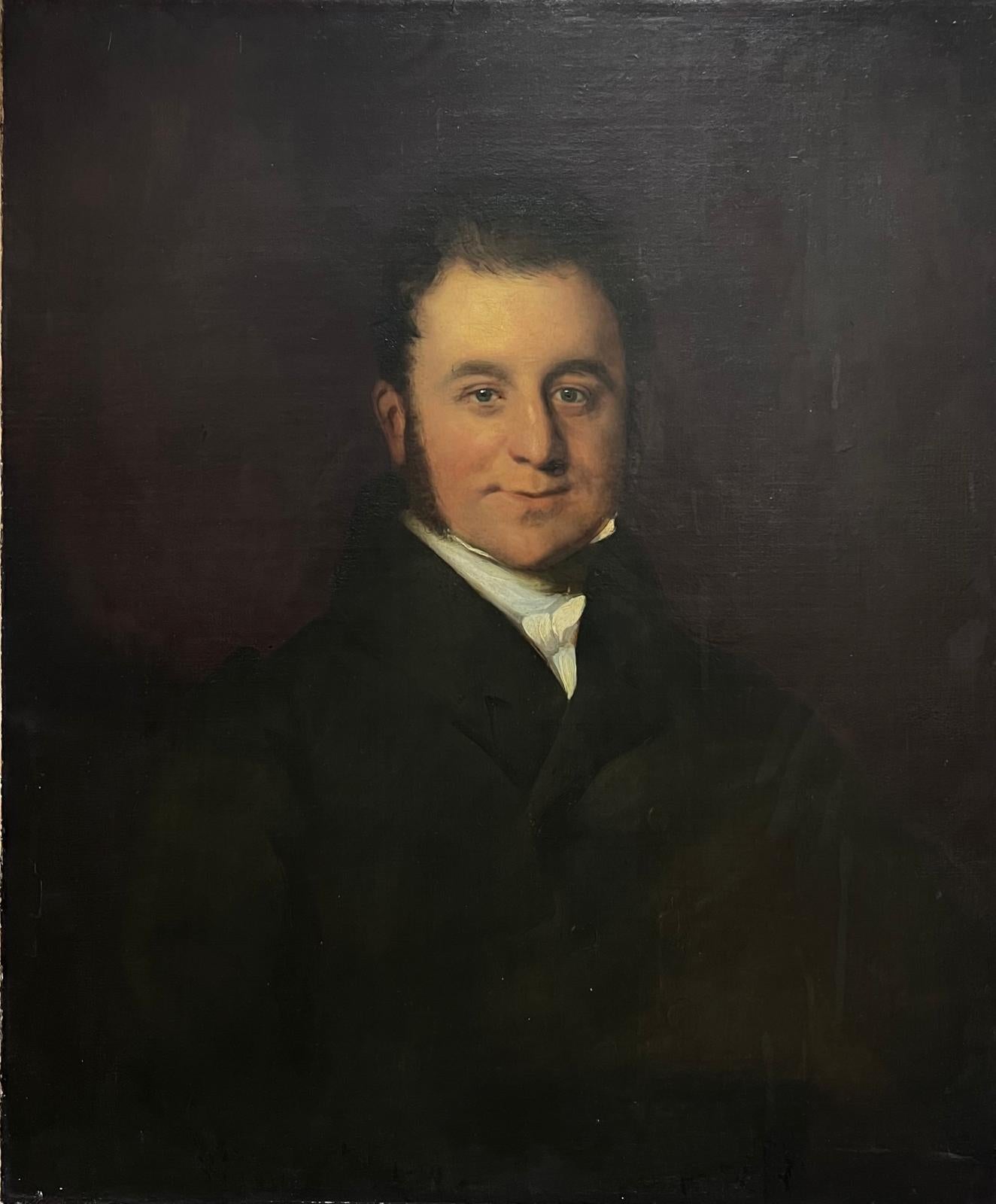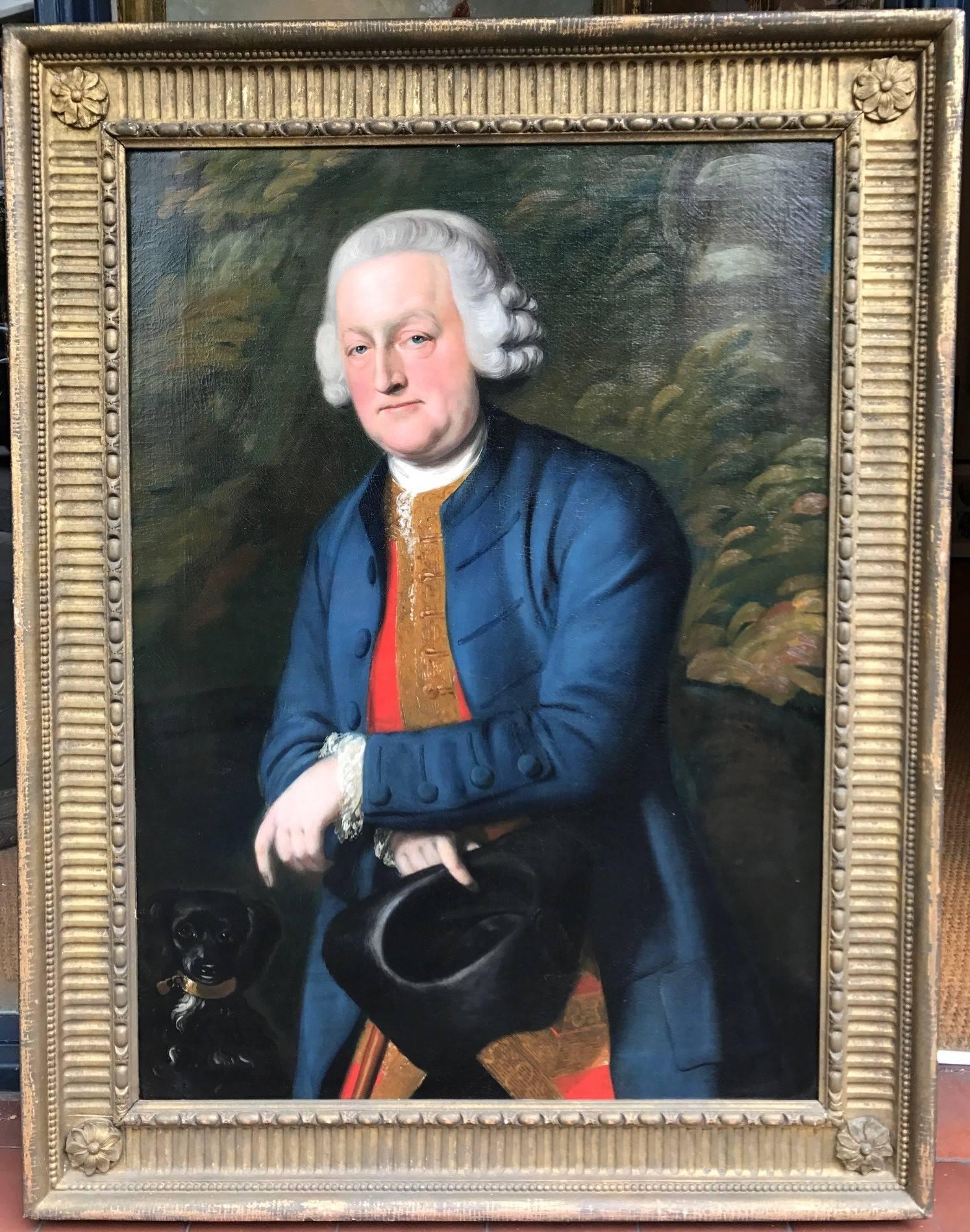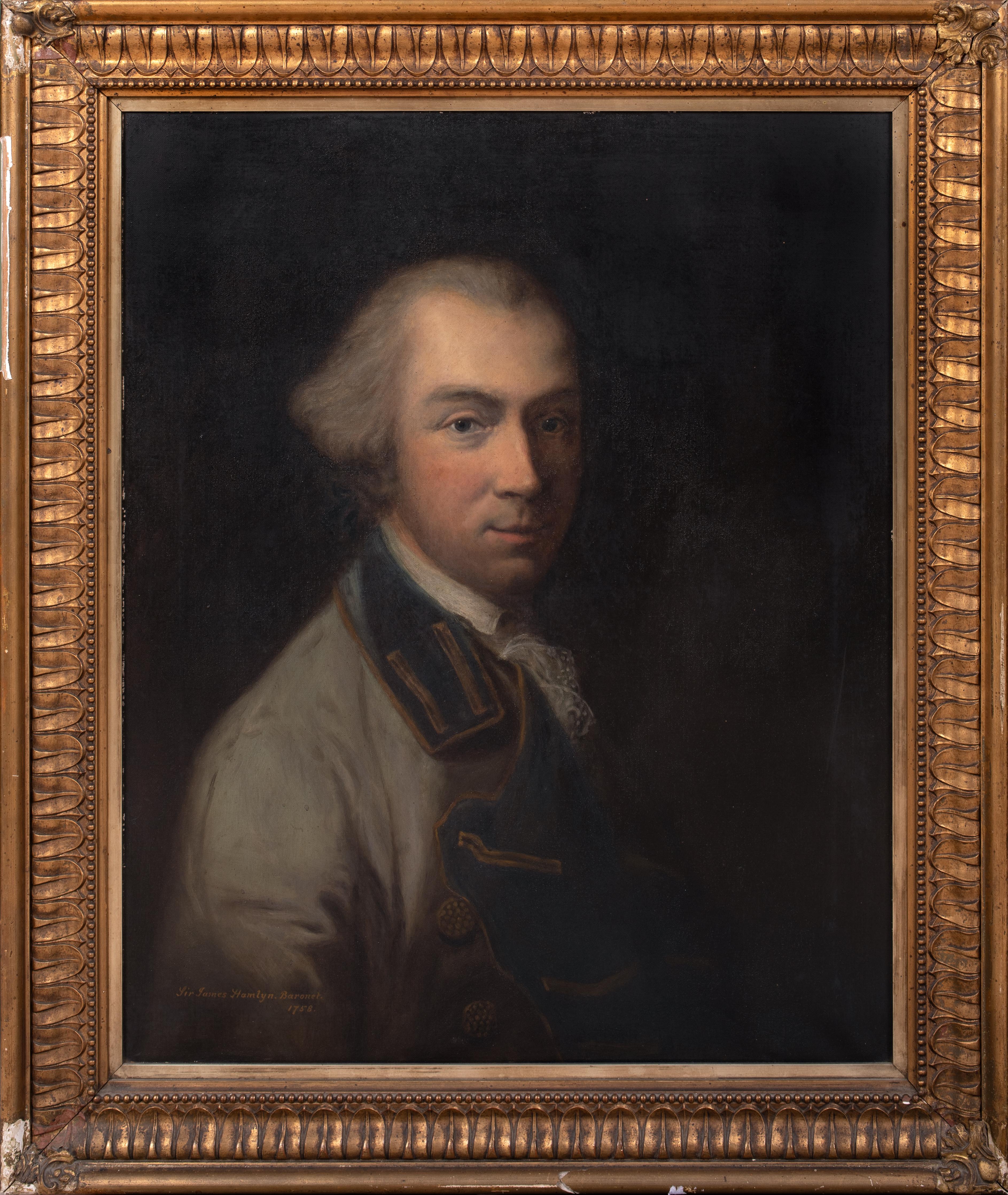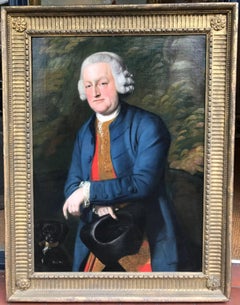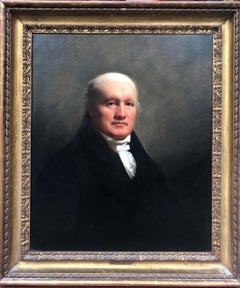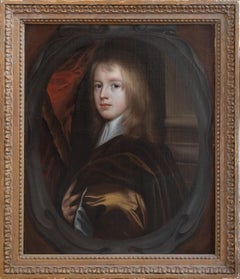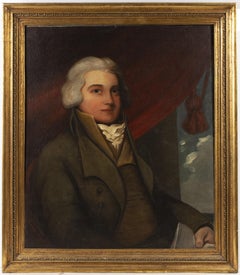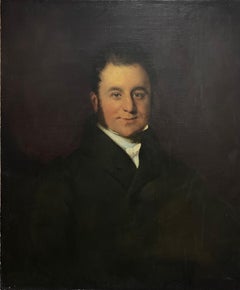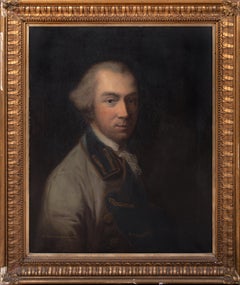Items Similar to Portrait of Owen Ormsby, bust-length, in a brown coat
Want more images or videos?
Request additional images or videos from the seller
1 of 7
Attributed to Gainsborough DupontPortrait of Owen Ormsby, bust-length, in a brown coatLate 18th century
Late 18th century
$10,237.99
£7,500
€8,744.44
CA$14,121.77
A$15,469.96
CHF 8,142.79
MX$184,638.05
NOK 103,799.91
SEK 94,888.76
DKK 65,319.40
About the Item
Attributed to Gainsborough Dupont (1754 - 1797, British)
Portrait of Owen Ormsby, bust-length, in a brown coat, with slightly later inscription identifying the sitter
oil on canvas
20 x 18 inches
PROVENANCE.
The Harlech Family since origin.
Thence by decent to Lord Harlech, his sale 2019.
Dupont was born in Sudbury, Suffolk, on 20 December 1754 the eldest son of Thomas Gainsborough's sister Sarah, and her husband Philip Dupont. In 1772 he was apprenticed to Gainsborough, for whom he continued to work until the latter's death in 1788. He was the only assistant Gainsborough is ever known to have employed. He also trained at the Royal Academy Schools, where he became a student in March 1775.
Dupont took over Gainsborough's studio in Schomberg House in 1788, and moved to Bloomsbury in 1793, following the death of Gainsborough's widow. He painted portraits and landscapes in a style of similar to that of his uncle, and also landscapes with architectural ruins, in which he imitated Nicolas Poussin. His principal work is a large picture containing the portraits of the elder brethren of Trinity House, which is in their court-room on Tower Hill.
The inscription including the date 1804 is of later date and has no bearings on the date of the work, it is only the date of death of the sitter.
- Creator:Attributed to Gainsborough Dupont (1754 - 1797)
- Creation Year:Late 18th century
- Dimensions:Height: 18 in (45.72 cm)Width: 20 in (50.8 cm)
- Medium:
- Period:
- Condition:
- Gallery Location:London, GB
- Reference Number:1stDibs: LU67337313152
About the Seller
5.0
Vetted Professional Seller
Every seller passes strict standards for authenticity and reliability
Established in 1990
1stDibs seller since 2017
45 sales on 1stDibs
Typical response time: 15 hours
- ShippingRetrieving quote...Shipping from: London, United Kingdom
- Return Policy
More From This Seller
View All18th Century Oil Painting Portrait of Phillip, 6th Viscount Wenman.
By Nathaniel Dance-Holland
Located in London, GB
Sir Nathaniel Dance-Holland (1750-1811) was an English portrait painter and one of the founding members of the Royal Academy in 1768. Justly celebrated in his lifetime he won several...
Category
Late 18th Century Old Masters Portrait Paintings
Materials
Oil
Striking 18th Century Portrait of the 12th Earl of Caithness
By Sir Henry Raeburn
Located in London, GB
Sir Henry Raeburn (1756-1823)
James Sinclair, 12th Earl of Caithness (1766-1823)
Oil on Canvas
30 X 25 inches Unframed
37 X 32 inches framed
Sir Henry Raeburn FRSE RA RSA (4 March 1756 – 8 July 1823) was a Scottish portrait painter and Scotland's first significant portrait painter since the Union to remain based in Scotland. He served as Portrait Painter to King George IV in Scotland.
Raeburn was born the son of a manufacturer in Stockbridge, on the Water of Leith: a former village now within the city of Edinburgh. He had an older brother, born in 1744, called William Raeburn. His ancestors were believed to have been soldiers, and may have taken the name "Raeburn" from a hill farm in Annandale, held by Sir Walter Scott's family. Orphaned, he was supported by William and placed in Heriot's Hospital, where he received an education. At the age of fifteen he was apprenticed to the goldsmith James Gilliland of Edinburgh, and various pieces of jewellery, mourning rings and the like, adorned with minute drawings on ivory by his hand, still exist. Soon he took to the production of carefully finished portrait miniatures; meeting with success and patronage, he extended his practice to oil painting, at which he was self-taught. Gilliland watched the progress of his pupil with interest, and introduced him to David Martin, who had been the favourite assistant of Allan Ramsay the Latter, and was now the leading portrait painter in Edinburgh. Raeburn was especially aided by the loan of portraits to copy. Soon he had gained sufficient skill to make him decide to devote himself exclusively to painting. George Chalmers (1776; Dunfermline Town Hall) is his earliest known portrait.
In his early twenties, Raeburn was asked to paint the portrait of a young lady he had noticed when he was sketching from nature in the fields. Ann was the daughter of Peter Edgar of Bridgelands, and widow of Count James Leslie of Deanhaugh. Fascinated by the handsome and intellectual young artist, she became his wife within a month, bringing him an ample fortune. The acquisition of wealth did not affect his enthusiasm or his industry, but spurred him on to acquire a thorough knowledge of his craft. It was usual for artists to visit Italy, and Raeburn set off with his wife. In London he was kindly received by Sir Joshua Reynolds, the president of the Royal Academy, who advised him on what to study in Rome, especially recommending the works of Michelangelo, and gave Raeburn letters of introduction for Italy. In Rome he met his fellow Scot Gavin Hamilton, Pompeo Girolamo Batoni and Byers, an antique dealer whose advice proved particularly useful, especially the recommendation that "he should never copy an object from memory, but, from the principal figure to the minutest accessory, have it placed before him." After two years of study in Italy he returned to Edinburgh in 1787, and began a successful career as a portrait painter. In that year he executed a seated portrait of the second Lord President Dundas.
Examples of his earlier portraiture include a bust of Mrs Johnstone of Baldovie and a three-quarter-length of Dr James Hutton: works which, if somewhat timid and tentative in handling and not as confident as his later work, nevertheless have delicacy and character. The portraits of John Clerk, Lord Eldin, and of Principal Hill of St Andrews belong to a later period. Raeburn was fortunate in the time in which he practised portraiture. Sir Walter Scott, Hugh Blair, Henry Mackenzie, Lord Woodhouselee, William Robertson, John Home, Robert Fergusson, and Dugald Stewart were resident in Edinburgh, and were all painted by Raeburn. Mature works include his own portrait and that of the Rev. Sir Henry Moncrieff Wellwood, a bust of Dr Wardrop of Torbane Hill, two full-lengths of Adam Rolland of Gask, the remarkable paintings of Lord Newton and Dr Alexander Adam in the National Gallery of Scotland, and that of William Macdonald of St Martin's. Apart from himself, Raeburn painted only two artists, one of whom was Sir Francis Leggatt Chantrey, the most important and famous British sculptor of the first half of the 19th century. It has recently been revealed that Raeburn and Chantrey were close friends and that Raeburn took exceptional care over the execution of his portrait of the sculptor, one of the painter's mature bust-length masterpieces.
It was commonly believed that Raeburn was less successful in painting female portraits, but the exquisite full-length of his wife, the smaller likeness of Mrs R. Scott Moncrieff in the National Gallery of Scotland, and that of Mrs Robert Bell, and others, argue against this. Raeburn spent his life in Edinburgh, rarely visiting London, and then only for brief periods, thus preserving his individuality. Although he, personally, may have lost advantages resulting from closer association with the leaders of English art, and from contact with a wider public, Scottish art gained much from his disinclination to leave his native land. He became the acknowledged chief of the school which was growing up in Scotland during the early 19th century, and his example and influence at a critical period were of major importance. So varied were his other interests that sitters used to say of him, "You would never take him for a painter till he seizes the brush and palette."
In 1812 he was elected president of the Society of Artists in Edinburgh; and in 1814 associate, and in the following year full member, of the Royal Scottish Academy. On 29 August 1822 he was knighted by George IV and appointed His Majesty's limner for Scotland at the Earl of Hopetoun house. He died in Edinburgh.
Raeburn had all the essential qualities of a popular and successful portrait painter. He was able to produce a telling and forcible likeness; his work is distinguished by powerful characterisation, stark realism, dramatic and unusual lighting effects, and swift and broad handling of the most resolute sort. David Wilkie recorded that, while travelling in Spain and studying the works of Diego Velázquez, the brushwork reminded him constantly of the "square touch" of Raeburn. Scottish physician and writer John Brown wrote that Raeburn "never fails in giving a likeness at once vivid, unmistakable and pleasing. He paints the truth, and he paints it with love".
Raeburn has been described as a "famously intuitive"portrait painter. He was unusual amongst many of his contemporaries, such as Reynolds, in the extent of his philosophy of painting directly from life; he made no preliminary sketches. This attitude partly explains the often coarse modelling and clashing colour combinations he employed, in contrast to the more refined style of Thomas Gainsborough and Reynolds. However these qualities and those mentioned above anticipate many of the later developments in painting of the 19th century from romanticism to Impressionism.
Sir Henry Raeburn died in St Bernard's House (17 St Bernards Crescent), Stockbridge, Edinburgh. He is buried in St. Cuthbert's churchyard against the east wall (the monument erected by Raeburn in advance) but also has a secondary memorial in the Church of St John the Evangelist, Edinburgh.
James Sinclair, 12th Earl of Caithness was born at Barrogill Castle (Castle of Mey) on 31 May 1766. He was the son of Sir John Sinclair of Mey, Baronet who he succeeded in the baronetcy in 1774. He succeeded as 12th earl of Caithness in 1789.
He was lord-lieutenant of the county of Caithness and lieutenant-colonel of the Ross-shire militia.
He married at Thurso Castle on 2 January 1784 Jane, second daughter of Alexander Campbell...
Category
18th Century Portrait Paintings
Materials
Oil
$29,485 Sale Price
40% Off
Free Shipping
17th Century Oil Painting Portrait of a Young English Boy
By Gerard Soest
Located in London, GB
Gerard SOEST (1600 - 1681)
Portrait of a Young Boy
oil on canvas
35.5 x 30.5 inches inc. frame
Gerard Soest (circa 1600 – 11 February 1681), also known as Gerald Soest, was a portra...
Category
17th Century Old Masters Portrait Paintings
Materials
Oil
A Portrait of a Gentleman, thought to be Moses Diego Lopez Pereira
Located in London, GB
Austrian School, 18th Century
A Portrait of a Gentleman, thought to be Moses Diego Lopez Pereira, 1st Baron d’Aguilar, in an elaborate coat and a powdered wig
Oil on canvas
Provena...
Category
18th Century Paintings
Materials
Canvas, Oil
19th Century Oil Painting Portrait of a Muse
Located in London, GB
John Opie RA (1761-1807, English)
c. 1802
Oil on canvas
Canvas dimensions 36 x 32 inches
Framed dimensions 46.5 x 43.25 inches
Original gilded period frame.
John Opie was a Corni...
Category
Early 19th Century Portrait Paintings
Materials
Oil
Sir Anthony Van Dyck 17th Century Oil Painting Study of a Head of a Man
By Anthony van Dyck
Located in London, GB
Sir Anthony Van Dyck (1599-1641, Flemish)
Study of a Head of Man
Circa 1627-32, Van Dyck’s second Antwerp period
Oil on paper, laid down on canvas
Dimensions 15 x 14 inches (38.1 x 3...
Category
17th Century Old Masters Portrait Paintings
Materials
Oil
You May Also Like
Portrait of a Gentleman in Crimson Coat - British 19th century art oil painting
Located in Hagley, England
This fine portrait oil painting is attributed to the circle of Joshua Reynolds. Painted circa 1800 it is a half portrait of a fine young man in a crimson velvet coat. The detail in h...
Category
Early 19th Century Realist Portrait Paintings
Materials
Oil
Fine 18th Century English Oil Portrait Smart Gentleman Squire holding Letter
By George Romney
Located in Cirencester, Gloucestershire
English School, circa 1780’s
Circle of George Romney (1734-1802)
oil painting on canvas, framed
framed: 36 x 30 inches
canvas: 30 x 25 inches
private collectio...
Category
Late 18th Century Old Masters Figurative Paintings
Materials
Oil
1830's British Oil Painting Large Portrait of a Distinguished Gentleman
Located in Cirencester, Gloucestershire
Portrait of an English Gentleman
English School, circa 1830's period
oil on canvas, unframed
Canvas: 30 x 24.5 inches
Provenance: Private collection, UK
Condition: relined canvas, ov...
Category
Early 19th Century English School Portrait Paintings
Materials
Oil, Canvas
Portrait Of Sir James Hamlyn (1735-1811), MP for Carmarthen, Sheriff of Devon
By Joshua Reynolds
Located in Blackwater, GB
Portrait Of Sir James Hamlyn (1735-1811), MP for Carmarthen, Sheriff of Devon, 18th Century
follower of Sir Joshua REYNOLDS (1723-1792)
Large 18th Century portrait of Sir James Ham...
Category
18th Century Portrait Paintings
Materials
Canvas, Oil
Portrait of Major General James Hanson Salmond - British 18thC art oil painting
By Sir Thomas Lawrence
Located in Hagley, England
This superb British Old Master oil painting is attributed to circle of Sir Thomas Lawrence. Painted circa 1795, the sitter is Major-General James Hanson Salmond (1766–1837) an office...
Category
1790s Old Masters Portrait Paintings
Materials
Oil
Artist Unknown Early 19th Century Portrait of Robert Burns Oil on Canvas
Located in Buchanan, MI
Artist unknown
(19th century)
Portrait of Robert Burns
Oil on canvas
Measures: 29 3/4 x 24 5/8 inches. Handsome and in very good conditions.
Category
Antique Early 19th Century English Regency Paintings
Materials
Giltwood
More Ways To Browse
A Dupont
19th Century Ball Gowns
Al Kaufman
Alfred Jonniaux
Alice Reynolds
Amy Hill
Anton Ebert
Boy With Violin
British Military Oil Paintings
British Military Portrait Painting
British Military Portrait
Charles Davies
Dali Kaufman
Earl Christy
Ebert Oil Painting
Edward De Vere
Flora Goddess Oil Painting
Frank Owen Salisbury On Sale

